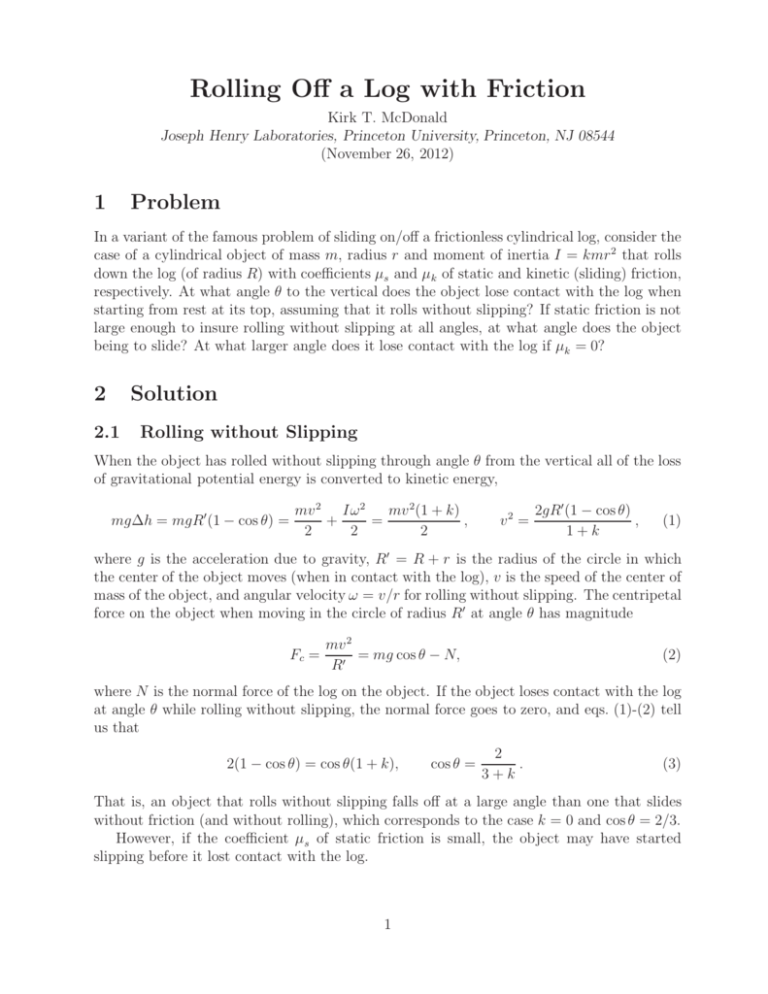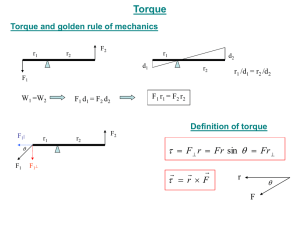Rolling Off a Log with Friction
advertisement

Rolling Off a Log with Friction Kirk T. McDonald Joseph Henry Laboratories, Princeton University, Princeton, NJ 08544 (November 26, 2012) 1 Problem In a variant of the famous problem of sliding on/off a frictionless cylindrical log, consider the case of a cylindrical object of mass m, radius r and moment of inertia I = kmr2 that rolls down the log (of radius R) with coefficients μs and μk of static and kinetic (sliding) friction, respectively. At what angle θ to the vertical does the object lose contact with the log when starting from rest at its top, assuming that it rolls without slipping? If static friction is not large enough to insure rolling without slipping at all angles, at what angle does the object being to slide? At what larger angle does it lose contact with the log if μk = 0? 2 Solution 2.1 Rolling without Slipping When the object has rolled without slipping through angle θ from the vertical all of the loss of gravitational potential energy is converted to kinetic energy, mgΔh = mgR (1 − cos θ) = mv 2(1 + k) mv 2 Iω 2 + = , 2 2 2 v2 = 2gR (1 − cos θ) , 1+k (1) where g is the acceleration due to gravity, R = R + r is the radius of the circle in which the center of the object moves (when in contact with the log), v is the speed of the center of mass of the object, and angular velocity ω = v/r for rolling without slipping. The centripetal force on the object when moving in the circle of radius R at angle θ has magnitude Fc = mv 2 = mg cos θ − N, R (2) where N is the normal force of the log on the object. If the object loses contact with the log at angle θ while rolling without slipping, the normal force goes to zero, and eqs. (1)-(2) tell us that 2(1 − cos θ) = cos θ(1 + k), cos θ = 2 . 3+k (3) That is, an object that rolls without slipping falls off at a large angle than one that slides without friction (and without rolling), which corresponds to the case k = 0 and cos θ = 2/3. However, if the coefficient μs of static friction is small, the object may have started slipping before it lost contact with the log. 1 During rolling without slipping the tangential acceleration at follows from the time derivative of eq. (1), mgR sin θ θ̇ = mg sin θ v = mvat(1 + k), at = g sin θ , 1+k (4) noting that θ̇ = v/R . The tangential force Fs ≤ μs N of static friction (that torques up the rolling object) opposes the tangential component mg sin θ of the force of gravity on the object, mat = mg sin θ = mg sin θ − Fs , 1+k (5) 2mg(1 − cos θ) kmg sin θ , = Fs ≤ μs N = μs mg cos θ − 1+k 1+k (6) recalling eqs. (1)-(2). Thus, for rolling without slipping the coefficient of static friction must satisfy μs ≥ k sin θ . (3 + k) cos θ − 2 (7) Since the denominator of eq. (6) vanishes when the object loses contact with the log according to eq, (3), the object could still be rolling without slipping at that moment only if μs were infinite. Hence, the object always starts to roll with slipping before it loses contact with the log, at angle θs related by cos θs = 2 + (k/μs ) sin θs , 3+k (8) where 2gR (1 − cos θs ) , 1+k (9) dv dv dθ v dv 1 dv 2 = = = , dt dθ dt R dθ 2R dθ (10) vs2 = recalling eq. (1). 2.2 Rolling with Slipping Noting that at = and that Fs = μk N once the object slips, the θ-equation of motion (5) can be written m dv 2 μk mv 2 N = mg(sin θ − μ cos θ) + , = mg sin θ − μ k k 2R dθ R 2 (11) recalling the radial equation of motion (2). That is, dv 2 = 2gR (sin θ − μk cos θ) + 2μk v 2 dθ (θ > θs ). (12) For nonzero μk , this equation is not integrable analytically, but in the approximation that sliding friction is negligible, we find v 2 = vs2 + 2gR (cos θs − cos θ) = 2gR 1 − cos θ . 1+k (μk = 0, θ > θs ). (13) Using this in the radial equation of motion (2), we find that the normal force vanishes for cos θ = 2 2 2 < < 3 + 3k 3+k 3 (μs > 0, μk = 0). (14) Hence, in the case of rolling without slipping up to angle θs (given by eq. (8)), followed by slipping without friction thereafter, the object loses contact with the log at a larger angle θ, related by eq. (14), than in the famous case of a point mass that slides without friction (cos θ = 2/3), and also at a larger angle than eq. (3) if the object could roll without slipping until it loses contact (cos θ = 2/(3 + k)). 3







